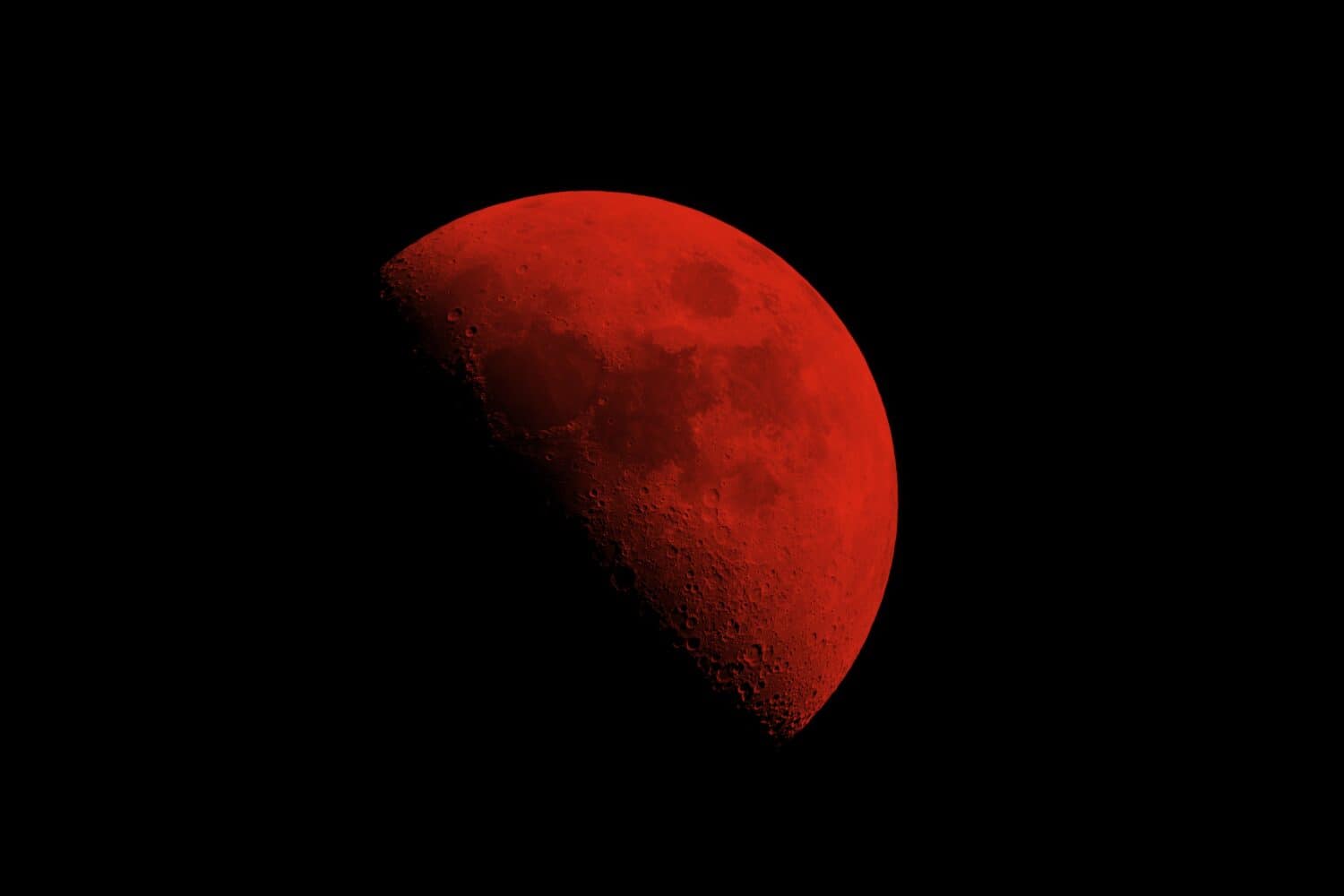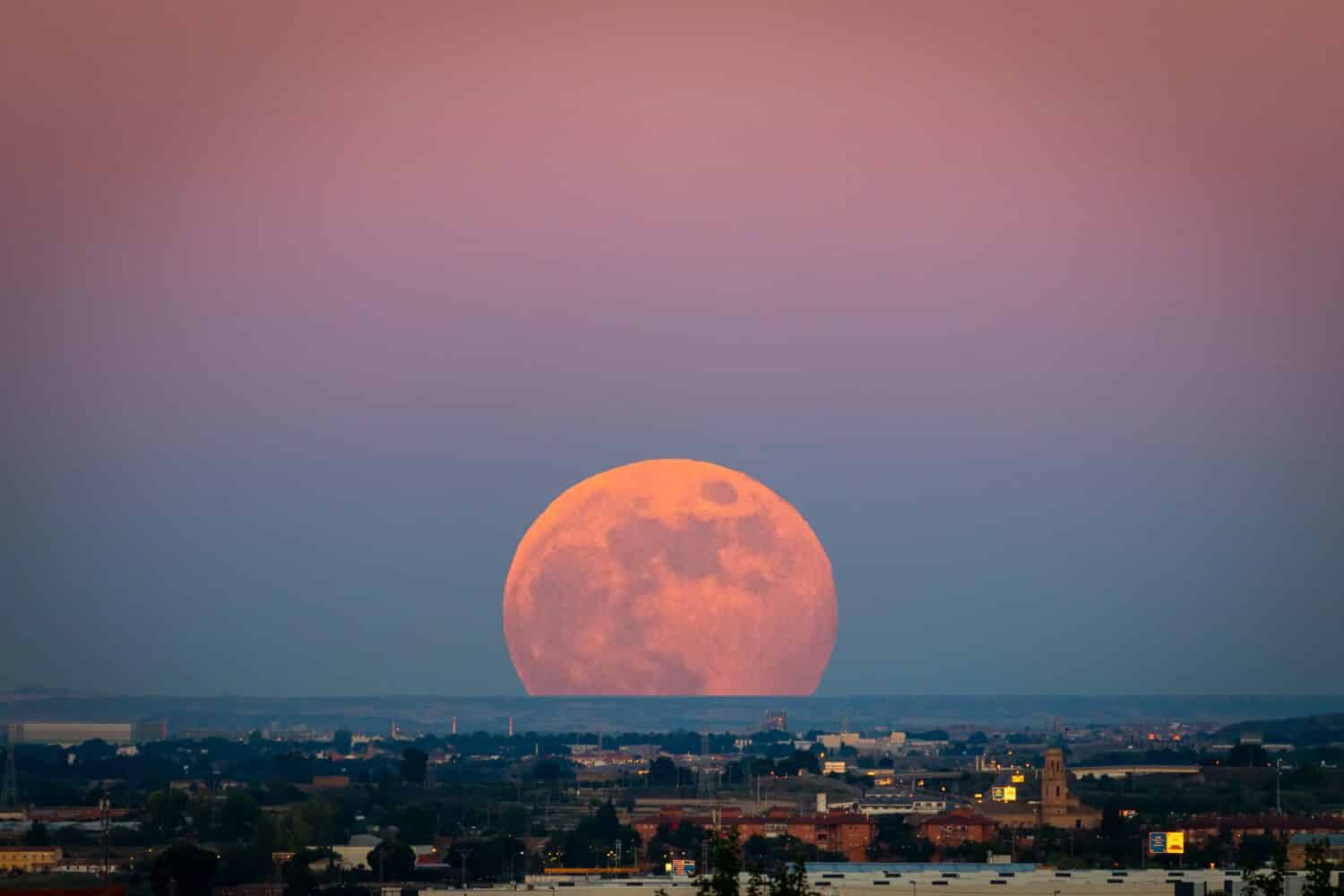What color is the Moon? The answer depends on the night and the time of night. The Moon formed roughly 4.5 billion years ago and it’s mostly gray. But it doesn’t always look that way. Sometimes the moon can appear bright white, yellow, orange, and even red. In this article, we’re going to explore the reasons behind these color changes, along with other cool Moon facts.
So, follow along as we discover the different colors of the Moon and the science behind them. We’ll also touch on the Moon illusion and learn how to finally break it.
1. Gray

The Moon has a dull gray color because of the minerals found on its surface.
©Quaoar/Shutterstock.com
The Moon’s true color is a dull gray, thanks to the minerals that form it. The Moon’s surface is primarily composed of minerals including magnesium, iron, calcium, silicon, feldspar, and pyroxene. There’s magnesium and iron in the Moon’s crust, and the other elements are all over its surface. In dust form, these minerals look gray, giving the Moon its real color.
Lighter-colored rocks on the Moon are typically composed of plagioclase feldspar, while darker rocks consist of pyroxene. Uncommon green-hued rocks called olivine are also present on the Moon. The Moon’s surface also contains other elements and minerals in trace amounts, but there are not enough of them to change the color.
Moon Volcanoes
A big part of the Moon’s front side has dark flat areas called maria. These happened because of powerful volcanoes, the strongest ones were about 3 billion years ago. The eruptions became less active around 1 billion years ago but didn’t completely stop. There’s a special place called Ina that scientists found, and it looks like a volcanic hole. They found clues that show it might have erupted as recently as 10 million years ago. After finding this, scientists saw about 70 more places on the Moon where lava probably flowed within the last 100 million years. This means the Moon’s been much more active than researchers previously thought. Perhaps further changes to it’s appearance and surface are yet to come.
2. Red

Red wavelengths are longer and reflect off the surface of the moon during an eclipse.
©pinkfloyd yilmaz uslu/Shutterstock.com
The Moon turns red during blood moons. The oldest known documented blood moon occurred on May 3, 1375, B.C., darkening the sky for an entire 2 minutes and 7 seconds. Blood moons are phenomena that happen during a lunar eclipse.
The intensity of the red color of a blood moon depends on its position in Earth’s shadow during a lunar eclipse. The Moon appears deep red when it’s in the darkest part of the shadow, known as the umbra, and light red when it’s in the partial shadow or penumbra.
Not all blood moons will look super red, and some might not even be visible from certain places on Earth. And during super flower blood moons, the Moon is both gigantic and red. According to NASA, the next super flower blood moon is going to be October 8, 2033.
Why Is the Moon Red During a Lunar Eclipse?
A lunar eclipse is when the Earth aligns between the Moon and the Sun, stopping direct sunlight from reaching the Moon’s surface. But even though the Earth blocks direct sunlight, the Moon is still lit up with a lovely red hue, and sometimes orange. The reason for the color swap has to do with the way the sunlight is reflecting.
Sunlight, a type of white light, contains all visible colors. On normal nights, when the sunlight reaches the Moon, all of the colors reflect back. This makes it appear a luminous bright white. But during a lunar eclipse, the Earth is in blocking the light. So the only way for the light to reflect the surface is by passing through the Earth’s atmosphere.
Colors like blue and yellow, have short wavelengths. When they interact with the air molecules in Earth’s atmosphere they become so scattered they never reach the Moon. But long wavelengths, like red wavelengths, are the least scattered. They’re able to reflect off the surface, giving it a lovely lunar red hue.
3. Yellow

The moon looks yellow when it’s low on the horizon.
©13Ports/Shutterstock.com
Is yellow your favorite color? When the Moon is low on the horizon, it takes on a gorgeous yellow color. This is because the moonlight (sunlight reflecting) travels through more air compared to when it’s high up in the sky. As the light passes through the air, it encounters tiny particles that push the shorter light waves, such as blue, and green in different directions. These colors scatter away and don’t reach our eyes. What we end up seeing are longer light waves, like yellow, orange, and red. Sometimes the Moon is a perfect blend of all three warm colors.
Yellow-Orange Strawberry Moon
With a name like the strawberry moon, you’d think it’s pink. But the name doesn’t have anything to do with the Moon’s color. Instead, it originates from the Algonquin tribes in the northeastern United States, who’d collect strawberries during this special moon. During a strawberry moon, the Moon seems closer to the ground in the Northern Hemisphere. These moons look warm and orange, like a sunset, and only happen once a year.
4. Orange

The position of the moon low on the horizon can also make the moon look orange.
©Teo Tarras/Shutterstock.com
Have you ever looked up at the big orange Moon and thought it looked like a tasty block of sharp cheddar? People have been joking about the Moon being made of cheese for centuries. Of course, we know there aren’t dairy products giving the Moon its color. So, why then does the Moon sometimes appear orange? Similar to the yellow colors, it has to do with where it’s sitting on the horizon.
When the Moon is low on the horizon, it turns orange instead of its usual silver color high in the sky. This happens for a similar reason as the Sun sometimes appears red during sunrise or sunset. It’s all about the way its light passes through the Earth’s air. When the Moon is low, its light travels through more air, which changes its color, making it appear a light reddish-orange.
It’s normal for the Moon to appear yellow and sometimes orange when it’s low on the horizon. But what about if it’s high up in the sky? When the Moon is high in the sky and orange, it might mean there’s smoke or pollution in the air. Tiny things in the air, like smoke or dust, can give it an orange/red color.
The Harvest Moon
Unlike other full moons linked to specific months, the orange-red harvest moon is associated with the autumnal equinox. This equinox occurs when the sun shines directly on the equator, equally lighting up both hemispheres. In the Northern Hemisphere, this transpires in September, with occasional occurrences in October every three years. In the Southern Hemisphere, it usually takes place in March. The extra light the Moon gives off fills the evening with a radiant glow. In times before electricity, farmers relied upon this bright light while harvesting their crops.
5. Blue Moons Aren’t Really Blue

Blue moons aren’t really blue; it’s a term for the rare second blue moon in a calendar cycle.
©Lukasz Pawel Szczepanski/Shutterstock.com
Blue moons are rare, and they’re not actually blue. The term blue moon describes when a second full moon appears within a single calendar month. Typically, we experience one full moon per month. However, due to occasional misalignment between the Moon’s cycle and our calendar, a second full moon, known as a blue moon can happen. They only happen about every two and a half years.
Krakatau Turned the Moon Blue
Volcanic eruptions can make the Moon appear to be blue. In 1883, the volcanic eruption of Krakatau marked one of the most catastrophic geological events in history. The eruption released a lot of sulfur dioxide and fine particles like ash into the atmosphere, scattering shorter wavelengths of light. The result was an eerie blue-looking Moon. Several other major volcanic eruptions, such as the El Chichon eruption in Mexico in 1982, the Mt. St. Helens eruption in 1980, and the Mount Pinatubo eruption in the Philippines in 1991, have also made the Moon look blue. And extreme forest fires can have a similar effect.
What Is the Moon Illusion?

The moon illusion makes the moon can look much larger depending on where it is on the horizon.
©Ivan Morato photography/Shutterstock.com
The Moon doesn’t just appear to change color. It also appears to change size because of the moon illusion. This is where the Moon looks bigger near the horizon when rising or setting. Although pictures show the Moon stays the same size, our eyes see it as larger.
There’s a simple way to break the moon illusion. Try this:
- With your right hand, create a circle or use a cardboard paper towel roll.
- Position your hand or roll between your eye and the Moon, as if it’s a pair of binoculars.
- Look at the Moon through the circle or roll. You’ll see it appears regular in size, just like normal.
- Now, look at the Moon without the frame (your hand or roll). It will instantly appear large again.
Why does this illusion happen? We’re not quite sure.
Scientists still don’t have a complete explanation for what makes the Moon appear so large near the horizon. Some ideas suggest that our brains think things are bigger when they’re closer and near the horizon. However, even astronauts in space see this illusion, so there’s more to this puzzle to figure out. What we do know is the Moon’s not suddenly getting closer to Earth during the course of an evening. Its movements happen slowly over the course of the month, and even close-up supermoons are only about 7% bigger.
Summary of the 5 Colors of the Moon
| Number | Color | Reason |
|---|---|---|
| 1 | Gray | Minerals on the Moon’s surface. |
| 2 | Red | The way red light reflects off the Moon’s surface during an eclipse. |
| 3 | Yellow | The low position of the Moon on the horizon. |
| 4 | Orange | The low position of the Moon on the horizon. |
| 5 | Blue | Blue moons aren’t truly blue. If the Moon appears blue it’s from something in the air like volcanic ash. |
The photo featured at the top of this post is © Fernando Astasio Avila/Shutterstock.com
Thank you for reading! Have some feedback for us? Contact the AZ Animals editorial team.







